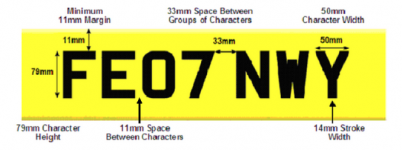Alfadeke21
Member
I have a 2007 Panda on a personal plate originally issued in 1994. They are metal plates, black on white & yellow reflective backings, numbers are correct size, script & spacing.
The only items missing are the BS number & the plate maker’s name & postcode. Up to now I’ve have had no problems with MOT’s. However the latest tester failed the car on “incorrect plates”. & hit me for the cost of new replacements & fitting them(!) £25 - or accept a fail. His argument was that the numbers were wrong size & wrongly spaced (by 1-2 mm possibly) & may not be able to be read by cameras.
My argument was that the plates were correct at the original 1994 issue date & were valid even when fitted to a vehicle first registered at a later year, 2007. The BS standards came in just after my 1994 number & my understanding is that most, if not all, MOT requirements are never retrospective.
I don’t have access to the Tester’s Manual, but on a trawl through the internet could find nothing to prove me right or wrong.
Does anyone have any thoughts, I wonder?
The only items missing are the BS number & the plate maker’s name & postcode. Up to now I’ve have had no problems with MOT’s. However the latest tester failed the car on “incorrect plates”. & hit me for the cost of new replacements & fitting them(!) £25 - or accept a fail. His argument was that the numbers were wrong size & wrongly spaced (by 1-2 mm possibly) & may not be able to be read by cameras.
My argument was that the plates were correct at the original 1994 issue date & were valid even when fitted to a vehicle first registered at a later year, 2007. The BS standards came in just after my 1994 number & my understanding is that most, if not all, MOT requirements are never retrospective.
I don’t have access to the Tester’s Manual, but on a trawl through the internet could find nothing to prove me right or wrong.
Does anyone have any thoughts, I wonder?


